
About UsThe Numismatic Bibliomania Society is a non-profit organization promoting numismatic literature. For more information please see our web site at coinbooks.org SubscriptionsThose wishing to become new E-Sylum subscribers (or wishing to Unsubscribe) can go to the following web page link MembershipThere is a membership application available on the web site Membership Application To join, print the application and return it with your check to the address printed on the application. Membership is only $15 to addresses in the U.S., $20 for First Class mail, and $25 elsewhere. For those without web access, write to: David M. Sundman, Secretary/TreasurerNumismatic Bibliomania
Society AsylumFor Asylum mailing address changes and other membership questions, contact David at this email address: dsundman@LittletonCoin.com SubmissionsTo submit items for publication in The E-Sylum, just Reply to this message, or write to the Editor at this address: whomren@coinlibrary.com
BUY THE BOOK BEFORE THE COINYou won't regret it! |
- WAYNE'S WORDS: THE E-SYLUM SEPTEMBER 16, 2012
- THE ASYLUM APRIL-JUNE 2012 ISSUE
- LAKE BOOKS 112TH SALE RESULTS AVAILABLE
- KOLBE & FANNING SALE 126 COLOR PLATES AVAILABLE
- NEW BOOK: HOLEY DOLLARS AND DUMPS OF PRINCE EDWARD ISLAND
- NEW BOOK: STRIKE IT RICH WITH SILVER IN COIN ROLLS
- BOOK REVIEW: CONFEDERATE CURRENCY BY PIERRE FRICKE
- MORE ON IN-TEXT ILLUSTRATIONS VERSUS PLATES
- BOOK REVIEW: BRITISH COMMEMORATIVE MEDALS, 2ND EDITION
- FIRST U.S. COIN AUCTION CATALOG: THE 1851 LEWIS ROPER SALE
- A VISIT TO THE THIRD PHILADELPHIA MINT BUILDING
- NOTES FROM E-SYLUM READERS: SEPTEMBER 16, 2012
- ON THE PHILADELPHIA MINT'S JANVIER LATHES
- BALTIMORE GOLD COIN HOARD ARTICLE FROM 1935
- MORE ON THE SWITT FAMILY 1933 DOUBLE EAGLES DECISION
- ANA 2012 FALL NATIONAL MONEY SHOW EXHIBITS
- MONEY TALKS AT THE 2012 DALLAS ANA
- WAYNE'S NUMISMATIC DIARY: SEPTEMBER 16, 2012
- NOTES ON THE ALBANY CHURCH PENNY
- QUERY: WHAT IS A PORTUGALOZER?
- QUERY: GARRETT TAIPING REBELS SILVER CASH INFORMATION SOUGHT
- MUHAMMAD ALI RECEIVES LIBERTY MEDAL
- ARNOLD PALMER RECEIVES CONGRESSIONAL GOLD MEDAL
- THE FELIX WASSERMANN COLLECTION OF GOLD COINS
- COIN SMUGGLING ATTEMPTS THWARTED IN EGYPT AND ABU DHABI
- SIOUX CITY CORN PALACE FESTIVAL MEDALS
- MORE ON THAT ENGRAVED 1840-O HALF DOLLAR
- THE CURIOSITY'S 1909 CENT PICKS UP LAYER OF MARTIAN DUST
- WHAT COINS SHOULD ACCOMPANY FROZEN PEOPLE TO THE FUTURE?
- LIBRARIAN TATTOOS
- FEATURED WEB PAGE: PAINTINGS ON PENNIES
WAYNE'S WORDS: THE E-SYLUM SEPTEMBER 16, 2012

New subscribers this week include Buell Ish, Greg Burrus and Cole Danehower. Welcome aboard! We have 1,595 email subscribers, plus 190 followers on Facebook.
This week we open with information on the next issue of our print journal, The Asylum, and notes from numismatic literature dealers Fred Lake and Kolbe & Fanning. Next up are announcements of two new books and a review of Pierre Fricke's new book on Confederate Currency.
Other topics include Canadian numismatist Louis-Joseph Casault, the 1851 Lewis Roper sale, Janvier reducing lathes, the 1935 Baltimore coin hoard, my numismatic diary, medals for Muhammad Ali and Arnie Palmer, and the Felix Wasserman collection of gold coins.
To learn more about that engraved 1840-O Half Dollar, the PEI Holey Dollar, the “Dollar with Flying Eagle", Russian machinist Andrei Konstantinovich Nartov, the man who slept in the Library of Parliament, librarian tattoos, paranormal coins and currency, the only cent on Mars and what coins should accompany frozen dead people to the future, read on. Have a great week, everyone!
Wayne Homren
Editor, The E-Sylum
THE ASYLUM APRIL-JUNE 2012 ISSUE
Asylum editor David Yoon writes:
 Another issue of The Asylum is at the printers. Here are the contents:
Another issue of The Asylum is at the printers. Here are the contents:
- Myron Xenos - "You Don't Say": Numismatic Quarterly Quiz Roger S. Siboni, John L. Howes, and Buell Ish - The Collectors and Their Collections: A Chapter from The State Coinage of New Jersey
The contents list may look short, but this is actually a longer issue than usual. "The Collectors and Their Collections" is a preview of a chapter from an upcoming book that the American Numismatic Society is publishing; this chapter is a detailed history of the collecting of New Jersey coppers.
Roger Siboni adds:
The introductory page talks about the book in general and why we chose to preview this chapter with the Asylum readership.
And by the way, in a bold first, the book will now be jointly published by The ANS and the Colonial Coin Collectors Club. Ray Williams just would not let a book about New Jersey Coppers get published without C-4 having a part. He is relentless!
Note from the authors: What follows is an preview of a chapter from our book, The State Coinage of New Jersey. This book has been over a decade in the making and will be published by the American Numismatic Society around the end of this year or early next year—depending on the final editing, production, shipping, and the many other factors one does not consider when one has finished writing a book!
The book will be the first comprehensive treatment of New Jersey coppers since 1881, when Dr. Edward Maris published his landmark book, The Coins of New Jersey. Over the years, several numismatists have taken aim at this goal, but none of their projects were completed. Nevertheless, the authors are grateful for the scholarship they left behind, which helped make this effort possible.
Our book will cover the economic conditions of the Confederation period that created a need for this coinage, the politics involved in securing a state contract, the coiners and their operations, and collecting methodologies. It will also include quarter-page images of each variety, with an analysis of the diagnostics, pertinent history, rarity, and a condition census with provenances. It will also present to the New Jersey collecting community the various major die states for each variety.
But most relevant to our fellow Asylum readers is the chapter “Collectors and Their Collections.” This was a chapter we all enjoyed working with and contributing to. It chronicles the American collecting of New Jersey coppers from as early as McCoy through modern collecting and eBay, as well as everything in between. In many ways the journey of New Jersey coppers seemed to mirror the journey for many Colonial-era coins as well. Thus we thought a preview of this chapter may be of interest to the Asylum readership.
We do ask something in return. The subject of provenance chains is opaque at best. We did our best at tracing them correctly. However, we are certain that if anybody knows the nooks and crannies of provenance chains enough to spot details that we missed or got wrong, it will be the Asylum readership. So we request that any observations about such items be brought to our attention via e-mail to rogersiboni@gmail.com.
LAKE BOOKS 112TH SALE RESULTS AVAILABLE
Our 112th mail-bid sale of numismatic literature closed September 11, 2012, and you can find the prices realized for the sale on our web site at www.lakebooks.com/current.html .
Bidding was quite active with outstanding figures being posted for material that is rarely seen on the auction block.
We sincerely appreciate the participation of our many customers and hope that you will find more material of interest in our sale #113 which will have a closing in early December of this year.
Lake Books
6822 22nd Ave. N.
St. Petersburg, FL 33710
727-343-8055 Fax 727-381-6822
http://www.lakebooks.com
KOLBE & FANNING SALE 126 COLOR PLATES AVAILABLE
KOLBE & FANNING SALE 126
Color Plates Available for Numismatic Literature Sale Closing October 4
Kolbe & Fanning Numismatic Booksellers have made available a PDF containing color illustrations of many of the items from their upcoming 126th sale of important numismatic literature from around the world. The sale features material from several different consignors, including a significant number of lots from the library of the late F. Gordon Frost. The color plates (as well as the PDF version of the catalogue itself) can be downloaded from the firm’s website at www.numislit.com . The color plates are not included in the printed catalogue (which should be in the hands of bidders soon). They are only available from the website.
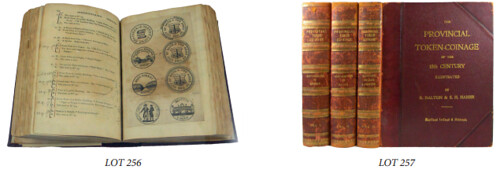
The mail-bid sale closes on Thursday, October 4, 2012. Phone bids will be accepted until 6 p.m. on that day; voicemail, fax and email bids will be accepted until midnight (all times are U.S. Eastern Time).
 Kolbe & Fanning Numismatic Booksellers
Kolbe & Fanning Numismatic Booksellers
141 W. Johnstown Road
Gahanna, OH 43230
(614) 414-0855
df@numislit.com
NEW BOOK: HOLEY DOLLARS AND DUMPS OF PRINCE EDWARD ISLAND
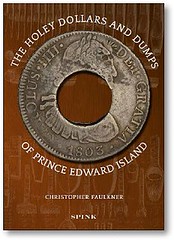 The PEI Holey Dollar, Canada’s most exotic and celebrated colonial-era coin.
The PEI Holey Dollar, Canada’s most exotic and celebrated colonial-era coin.
This is the first book-length study to be devoted to Canada’s most exotic and celebrated colonial-era coin, the Holey Dollar of Prince Edward Island and its accompanying Dump. The fruit of twenty years of research in international archives, libraries, and private and institutional collections, from as far afield as Charlottetown and Puerto Rico, Vancouver and London, this book uncovers the origins and history of a coin which has been shrouded in mystery for two hundred years.
Toronto, Ontario, Canada, September 28-29, 2012:
The Toronto Coin Expo is pleased to present author Christopher Faulkner and the launch of his book “The Holey Dollars and Dumps of Prince Edward Island” at the Toronto Reference Library in the Apple Salon, at 789 Yonge Street.
The Prince Edward Island Holey Dollar is one of the most renowned Canadian colonial coins, arousing deep numismatic and historical interest. The Dollar and its Dump represent a unique instance in the whole of British North America of the cutting and countermarking of a coin so that its parts might pass as legal tender.
Because they were made from Spanish-American Dollars, the most widely circulated coin of its day and a standard of value throughout the entire world, these coins have a legitimate place in many different sorts of collections: the Spanish American series; crown-sized coins of the world; cut and countermarked coins; emergency or proclamation coinage; semi-official colonial issues; and, finally, private merchants’ tokens. There is no other Canadian coin or token that can claim to be so many things to so many interests at once.
 The book’s Introduction elaborates the monetary and commercial circumstances, as well as the political and economic conditions, which led to the initial production of this unusual coin in 1813 and to its eventual disappearance over the ensuing years. To that end, the book addresses a number of provocative questions. Who made the Holey Dollars and Dumps? How were they made? How long did they circulate? What could they buy? What were their precedents? Can we distinguish a Government issue Dollar or Dump from contemporary merchant counterfeits? What motivated the counterfeiters?
The book’s Introduction elaborates the monetary and commercial circumstances, as well as the political and economic conditions, which led to the initial production of this unusual coin in 1813 and to its eventual disappearance over the ensuing years. To that end, the book addresses a number of provocative questions. Who made the Holey Dollars and Dumps? How were they made? How long did they circulate? What could they buy? What were their precedents? Can we distinguish a Government issue Dollar or Dump from contemporary merchant counterfeits? What motivated the counterfeiters?
In the course of addressing these questions, the author presents something of the texture of the places and peoples bound up with the Holey Dollar of PEI for the past two hundred years. The people that figure here include collectors and bystanders, merchants and government officials, and the places range from a Canadian homestead to an island in the Caribbean. An Appendix includes an original census of Charlottetown with heads of households for 1813.
About the Author: Christopher Faulkner is Distinguished Research Professor and Professor Emeritus at Carleton University, Ottawa, Canada, and a Fellow of the Canadian Numismatic Research Society. In the field of numismatics, his primary area of research interest is the pre-Confederation Canadian token coinage, and he has written a number of articles and book chapters on various aspects of the token coinage of the period.
The PEI Holey Dollar has always been highly prized by token collectors and remains extremely popular today. Geoffrey Bell Auctions is featuring one specimen in its upcoming sale in Toronto, September 27-28, 2012 at the Toronto Reference Library. The world will be bidding on this treasured piece of Canadian history.
The Holey Dollars and Dumps of Prince Edward Island is published by Spink, London, with the financial support of the J. Douglas Ferguson Historical Research Foundation. It is available in Canada from Svetolik Kovacevic at Ancient Numismatic Enterprise, Toronto (416 686-8019 or ane@vcoins.com), or at the upcoming Toronto Coin Expo.
Chris Faulkner adds:
Copies of the book will be shipped air freight directly from the printer to Toronto to arrive in time for the show.
Charles Davis will handle U.S. sales, although it won't be available in the U.S. until next month (at the equivalent of 65 pounds sterling).
To read the latest issue of moneta, see: www.ons-sno.ca/Moneta_CURRENT_PV.pdf
NEW BOOK: STRIKE IT RICH WITH SILVER IN COIN ROLLS
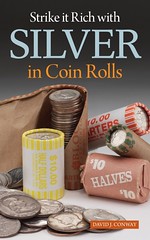 Experience the thrill of the hunt with Strike it Rich with Silver in Coin Rolls, a practical, hands-on information on how to easily search coin rolls to take advantage of the silver coins still floating in circulation. With information on how to search, where to look, what to look for and how to best profit from the coins, this book is sure to appeal to both the beginner collector or investor, as well as those looking for more specific information on coin rolls.
The book features practical, savvy information on profiting from hunting coin rolls, and vivid supporting images.
Experience the thrill of the hunt with Strike it Rich with Silver in Coin Rolls, a practical, hands-on information on how to easily search coin rolls to take advantage of the silver coins still floating in circulation. With information on how to search, where to look, what to look for and how to best profit from the coins, this book is sure to appeal to both the beginner collector or investor, as well as those looking for more specific information on coin rolls.
The book features practical, savvy information on profiting from hunting coin rolls, and vivid supporting images.
Geared toward the beginner collector looking for a simple and easy way into the precious metals market and rare coin world, this book is also a good resource for more advanced collectors looking for fleshed out information on searching coin rolls.
A coin collector for over 10 years, author David J. Conway is currently a student at George Washington University as well as the founder and owner of Cool Cash Coins, a coin appraisal and sales business, at coolcashcoins.com. Conway has been coin roll hunting since 2006, and has also developed a silver melt value calculator app for the iPhone. Conway has been featured for his work in Westport magazine, on PBS television show, "Bizkidz," and received the 2010 Young Entrepreneur of the Year award from the National Federation for Independent Business.
For more information visit www.sellcoinbooks.com/new-releases/strike-it-rich-with-silver-in-coin-rolls
BOOK REVIEW: CONFEDERATE CURRENCY BY PIERRE FRICKE
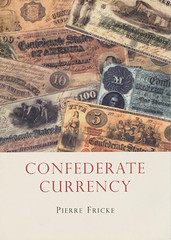 Confederate Currency, By: Pierre Fricke, 2012, Shire Publications Ltd, Midland House, West Way, Botley, Oxford OX2 OPH, United Kingdom, Reviewed by: John and Nancy Wilson NLG
Confederate Currency, By: Pierre Fricke, 2012, Shire Publications Ltd, Midland House, West Way, Botley, Oxford OX2 OPH, United Kingdom, Reviewed by: John and Nancy Wilson NLG
Confederate Currency, by Pierre Fricke was released in the summer of 2012. It is a small soft cover 56 page book. This book follows closely on the heels of the History of Collecting Confederate States of America Paper Money, Volume 1 by this same author and Fred Reed. The book covers, in an easy to read manner, the Seven Series of the Confederate States of America money, along with their financial history, and how the money fit into the Civil War and events of the time.
The First Chapter. “Financing A New Nation.” From the formation of the Confederacy in February, 1861, the book gives you a basic knowledge of the measures taken to establish a treasury and issue money for the CSA. After the War, Confederate notes began to appear appeared in auction in the mid-1860s and 1870s. Montgomery and other rare notes gained fame and value and a new hobby was born.
The First Series 1861. After Lincoln was elected and said his intention was to use force to protect federal property in the south, the CSA quickly moved to create paper money by passing an Act on March 9, 1861. The chapter tells you where the notes were printed and quantity. A timeline of important events such as on May 20-21 Kentucky and Missouri declared their neutrality follows.
The Second Series 1861. The first issue contained $1 million in notes. Unlike the first issue which bore interest, this issue would bear no interest and was payable two years after the date of a treaty. The contract with the Southern Bank Note Co. for printing the 20 million of Treasury notes and 10 million Coupon Bonds is covered, and why the bonds are so rare today. The lithographer, Hoyer & Ludwig (Richmond, VA.), was granted a contract to print the July 25, 1861 issues from $5 to $100 which were quickly counterfeited by Sam Upham (because of the low quality of paper and printing). A Timeline of events follows.
Printing Confederate Paper Money. All of the companies which printed CSA paper money as well as the printing techniques and plate layouts are explained.
The Third Series 1861 - 62. The Third Series has the largest and broadest array of varieties and paper types. Some illustrations along with a timeline of the period are included.
Counterfeit Confederate Paper Money. The chapter explains that counterfeit notes that were created during the Civil War are known as contemporary issues. Fake notes made after the war are called facsimiles or nineteenth-century or modern copies, depending on vintage.
The $100 7.3 Percent Interest-Bearing Notes of 1862 - 63. These notes were used by the government and military to buy supplies, etc. They were poorly printed and quickly counterfeited. The Act in April, 1862 authorized $170 million in notes and another Act in September, 1862 authorized $5 million of lower denomination $1 and $2 notes.
The Fifth Series 1862. Though the Act of October, 1862 authorized $90 million in notes, more than $138 million were issued. Pink paper was used in the smaller denominated notes to deter counterfeiting. White paper was used on the higher valued notes.
The Tran-Mississippi. It is a strategic area for the Confederacy, and the Union was able to cut off access to the area west of the Mississippi to the Confederacy. The lack of sufficient Confederate money to pay troops and suppliers played a key role in the losses in this theatre.
The Sixth Series 1863. An Act in March, 1863 authorized $50 million per month of paper money bearing no interest in denominations from $5 to $100, and $15 million more was authorized in denominations of $2, $1 and .50 for a total of $518 million.
The Seventh Series 1864 - 65. Denominations from .50 to $500 were authorized by an Act in February, 1864, and $200 million were issued. Inflation raged through this period.
Further Reading and the Index close out the book.
We highly recommend this 56 page book which covers the Confederate States of America seven different series of currency. Counterfeiting, depreciation and inflation of the issues is covered in a clear and concise manner. From being worthless at the end of the Civil War CSA notes started a steady price rise by the middle 1870s.
Quoting the press release for the reference, “Neither a price guide nor a catalog per se (see Collecting Confederate Paper Money by Pierre Fricke), Confederate Currency explains the origins of the various notes issued by the South, putting the money into historical context. Fricke also briefly discusses the dissolution of the Union and examines the collectability of Confederate Currency.”
Amazingly all the information you would ever want to know about these fascinating CSA issues will be found within a 56 pages. We recommend this book to anyone with an interest in the monetary history of the South, along with any collector, dealer or investor in paper money.
The book sells for $12.95 ppd and is available from the author at: Pierre Fricke, P. O. Box 1094, Sudbury, MA 01776. More information will be found at this web page: www.csaquotes.com/csabooks/confederatecurrencyintr.html .
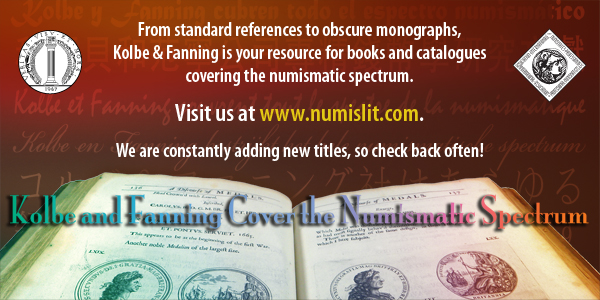
MORE ON IN-TEXT ILLUSTRATIONS VERSUS PLATES
Wow! I didn't mean to open a can of worms when I wrote about my displeasure with plates separated from numismatic item descriptions. I greatly appreciate, however, all those who wrote comments published in last week's E-Sylum.
I even received phone calls from friends who attempted to show me the error of my comments. It appears Admiral Vernon medals, Hard Times Tokens and Civil War tokens, to name a few, need to be illustrated adjacent to one another. The lettering differences is so minor in these series, it appears, that to determine a specific variety you need to examine a number of illustrations moving from one to another, comparing illustration with specimen in hand. Numismatists prefer to have these close together on a plate page.
Granted this is the case. I still contend these similar variety illustrations can be shown near their descriptions, on the same or facing page. If two or more numismatic items have such relationship they should be illustrated together near the description -- not elsewhere in the book, which was my complaint.
The group can be illustrated together for the purpose of identifying a specific variety.
This is a problem, not for the author, but for the graphic artist who lays out the book. The solution to such layout problems adds interest to the book. Often authors do not have the artistic talent to achieve what a professional book designer can achieve. (Another reason why self-published books are so boring.)
My critics' suggestion to have illustrations in both locations is an unnecessary redundancy.
To read the earlier E-Sylum article, see: READER THOUGHTS ON PLATES IN NUMISMATIC LITERATURE (www.coinbooks.org/esylum_v15n38a06.html)
BOOK REVIEW: BRITISH COMMEMORATIVE MEDALS, 2ND EDITION
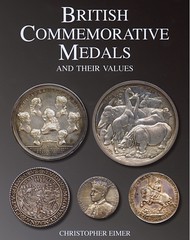 What precipitated the discussion on separated plates was the recently published book British Commemorative Medals, the second edition by Christopher Eimer. This is a fantastic book, with perhaps, this one major complaint.
What precipitated the discussion on separated plates was the recently published book British Commemorative Medals, the second edition by Christopher Eimer. This is a fantastic book, with perhaps, this one major complaint.
I wrote a 5-page analysis of this book (for my own use). I listed content, format, scope, what I liked and disliked about the book. (I frequently do this analysis for important books I want to remember what information is available and where it can be found.)
[I learned this from a college professor who said if you want to remember what's in a book, write a book report as lengthily and as fully as you can. Polish it, correct all typos. Then throw it away, delete all copies. By knowing in advance you are going to dispose of it, your mind will be challenged to remember it.]
Eimer's book illustrations are superb, all 2000 plus. How did he find such medals without a single scratch, dent or ding? A few early medals may have a rubbed nose, cheek, or breast, but the answer is medals were selected from seven museums and such, even "commercial and private sources." A major task.
I liked his descriptions, and his supplemental information for most medals, found in what he called "footnote data." This was smaller type in paragraphs following the description.
Speaking of small type, this was my second major dislike: too small type size for these old eyes. But I understand why -- to include everything for 2,230 medals to keep in one volume.
In his review of this book in The E-Sylum (vol 14, no 14, art 5) John Adams praised the list of medallists in the appendix. It is so comprehensive, I did not discover a single medallist not included! (Both personal artists and medal producers are called medllists. and so listed) Of the 629 medallists total I found 101 of American interest and 19 British producers who made medals of American interest.
I also recorded this trivia: William Wyon had more entries than any other medallist -- 70. David Pickup had more entries in the bibliography than any other author, all were articles in The Medal -- seven.
Okay, I criticized the plates separated from the descriptions, but I would highly praise this book for the author's superb knowledge of this field and this British series, plus his commendable scholarship at every level of the book.
Oh, if we only had a Chris Eimer to write the book for every medal-issuing country of the world!
To read the earlier E-Sylum article, see: BOOK REVIEW: BRITISH COMMEMORATIVE MEDALS AND THEIR VALUES, 2ND EDITION (www.coinbooks.org/esylum_v14n14a05.html)
FIRST U.S. COIN AUCTION CATALOG: THE 1851 LEWIS ROPER SALE
Until the mid-19th century, a few coins were occasionally offered in auctions of paintings or books, but never in a dedicated numismatic catalog. Then came Feb. 20 to 21, 1851, when Dr. Lewis Roper’s collection was sold at public auction in Philadelphia.
A dentist and pioneering coin collector, Roper was lucky to befriend William DuBois, assistant assayer of the Mint, who helped him find rarities. However, Roper was unlucky to die of cholera in 1850 while sailing home from the California gold fields.
His collection merited the first American catalog in which coins were the main event: Catalogue of the Entire Collection of Rare and Valuable Coins, Medals, Autographs, Mahogany Coin Case, & c., Late of Doctor Lewis Roper, Deceased, published by Moses Thomas & Sons of Philadelphia.
The Roper catalog is divided into sections offering coins from different eras and nations, and the descriptions are mostly familiar, although some sound strange to modern ears, such as “Dollar with Flying Eagle.” The overall organization is unusual, with 52 “lots,” each lot containing a number of individually numbered items; in all, the auction offered 698 coins and 21 autographs. No illustrations are included; not until 1869 would the first photographically illustrated American coin catalog appear.
The Roper name drew coin collectors from Philadelphia, Boston and New York City. So many attended that Thomas & Sons had to reprint the catalogs. These two printings can be distinguished by examining the bottom fourth of page 24. In the first printing, this area is blank; in the second, the following appears: “M. Thomas & Sons, Philada., February, 1851 Auctioneers, 93 Walnut Street.”
Collectors in attendance competed for delicacies such as a 1792 half disme, a 1794 Flowing Hair dollar, an 1848 Coronet, CAL. quarter eagle, and two original Libertas Americana medals.
Numismatic bibliophiles love the Roper catalog — first or second printing — and bid thousands of dollars when one comes onto the market. Perhaps 10 to 12 copies survive outside of institutional collections, making this catalog rarer than an 1804 silver dollar.
To read the complete article, see: The 'granddaddy' of catalogs: First U.S. coin auction catalog (www.coinworld.com/articles/the-granddaddy-of-catalogs/)
A VISIT TO THE THIRD PHILADELPHIA MINT BUILDING
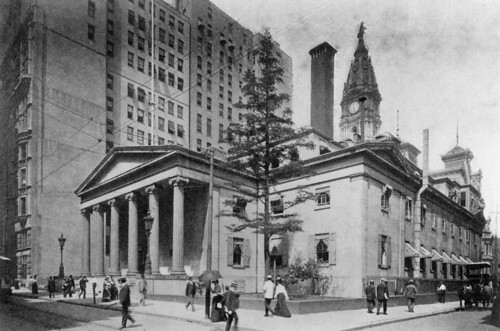
Last week I mentioned my August 7 visit to the Fourth Philadelphia Mint. On the following day I walked North and West of my hotel to visit the Philadelphia Community College in the building that was the Third Philadelphia Mint. The building on Spring Garden Street looks just like the many postcards published when the Mint was in operation. Other college buildings have been added and signs identify the old building as the Mint Building.
I walked up the steps and into the lobby. There I negotiated with a security guard to walk around the first floor. He apologized that he had no one on staff to take my farther through the building. He also mentioned that the basement still has huge vaults.
The first floor halls have arched ceilings decorated with ceramic tiles in geometric patterns. Over some of the doorways were circles of undecorated plaster. These were the locations of the mosaics now on display in the lobby of the Fourth Mint. I suspect that most students at the college are not even aware that the Mint mosaics are missing.

I also visited the Fourth Mint when the ANA convention was there in 2000. The mozaic panels are clearly a display of items from the past and do not fit into the modern style of the current Mint. This time I bought a set of postcards to remind me of their color and beauty.
To read the earlier E-Sylum article, see: PHILADELPHIA MINT TOUR PHOTOS: TIFFANY, PETER AND JANVIER (www.coinbooks.org/esylum_v15n38a17.html)
NOTES FROM E-SYLUM READERS: SEPTEMBER 16, 2012
A Charles Fremantle Portrait
 Regarding Dennis Tucker's quest for an image of Charles William Fremantle, deputy master of the British Royal Mint,
Jim Duncan of New Zealand writes:
Regarding Dennis Tucker's quest for an image of Charles William Fremantle, deputy master of the British Royal Mint,
Jim Duncan of New Zealand writes:
Challis' New History of the Royal Mint has an excellent portrait of Fremantle on p.515. Looks very Edward VII
To read the earlier E-Sylum article, see: QUERY: CHARLES WILLIAM FREMANTLE PORTRAIT SOUGHT (www.coinbooks.org/esylum_v15n38a14.html)
Were the 1817 Jolas Cast?
Regarding how the 1817 Jolas were made, Joe Boling writes:
 I would suggest that the entire coin was cast, not just the planchets. That was my first impression on seeing the illustration last week, and in light of Richard Doty's comment, I'd expect that they were cast completely, not hammered on cast planchets.
I would suggest that the entire coin was cast, not just the planchets. That was my first impression on seeing the illustration last week, and in light of Richard Doty's comment, I'd expect that they were cast completely, not hammered on cast planchets.
To read the earlier E-Sylum article, see: QUERY: HOW WERE THE 1817 JOLAS MADE? (www.coinbooks.org/esylum_v15n38a13.html)
More on the Curved Baseball Commemorative
Joe Boling writes:
The US scyphate commemorative that I mentioned two weeks ago is further along than I thought - it's already law, signed on 3 August (see this month's issue of The Numismatist, p 27). It's the Baseball Hall of Fame commemorative, coming in 2015 to a ball field near you.
The two denominations will have concave obverses and convex reverses, the better to look like a baseball. The article says that the legislative sponsor promises that "proceeds from the sales will cover the coins' production costs." So costs go through the roof, and nobody springs for the coins - the Baseball Hall of Fame gets nothing, because surcharges only get disbursed after costs are covered. I am not optimistic about ever seeing this hare-brained design.
To read the earlier E-Sylum article, see: MORE ON CURVED COINS (www.coinbooks.org/esylum_v15n37a11.html)
The SpongeBob SquarePants Coins
Regarding the SpongeBob SquarePants coins, Kerry Rodgers passed along a link to an article he'd written on them in World Coin News (August 27, 2012). Thanks.
To read the complete article, see: Silver SpongeBob Seized (www.numismaster.com/ta/numis/Article.jsp?ad=article&ArticleId=25688)
Gar Travis writes (sarcastically):
Wow they do retail for $259!
Gar included this item from the Nickelodeon web site:
 Your SpongeBob fan will totally dig these clams—errr, coins! The SpongeBob Squarepants Coin Set comes with a super cool treasure chest and an individually numbered Certificate of Authenticity from the New Zealand Mint. But get your fins on this set soon—it's a limited release!
Your SpongeBob fan will totally dig these clams—errr, coins! The SpongeBob Squarepants Coin Set comes with a super cool treasure chest and an individually numbered Certificate of Authenticity from the New Zealand Mint. But get your fins on this set soon—it's a limited release!
To read the complete article, see:
SpongeBob SquarePants Premium Bullion Coin Set
(www.parentsconnect.com/product-review/toys/
spongebob-collector-coins.html)
To read the earlier E-Sylum article, see: THE CASE OF THE MISSING SPONGEBOB COINS (www.coinbooks.org/esylum_v15n38a26.html)
Musician vs Royal Canadian Mint
Halifax folk musician Dave Gunning wanted to pay tribute to the soon-to-vanish Canadian penny in song with his upcoming album No More Pennies.
But the Royal Canadian Mint was not happy about the image of the Canadian penny he is using on the album cover. It says Gunning is contravening copyright and must pay a fee.
For every 2000 copies of the album he creates he has to fill out an application, wait for approval and be charged $1,200.
So, Gunning has launched a penny drive, requesting that fans bring pennies to his fall shows so he can afford to issue his album.
The Ottawa-based mint has waived the fee on the first 2,000 albums, to come out Sept. 18. But it is firm that Gunning must pay up for future releases.
A mint spokeswoman confirmed that there is copyright on images of coins.
To read the complete article, see: Mint charges musician pretty penny for use of coin image (www.cbc.ca/news/offbeat/story/2012/09/10/dave-gunning-penny.html)
ON THE PHILADELPHIA MINT'S JANVIER LATHES
Joe Boling writes:
I saw the 1907 Janvier lathe at the Mint and was astounded that it was that new. I had thought that the technology was decades older than that. Was the mint just slow to get on board?
Technology for copying and reducing machines dates to the late 17th century, with considerable progress being made in the latter 18th century by several machinists and inventors in France, Russia and England. Their original goal was to make reduced-side copies (or molds) of sculpture so that the copies could be sold to well-to-do families.
Russian machinist Andrei Konstantinovich Nartov seems to have invented a foot powered “medallic copier lathe” sometime before 1747 and described it in his 1755 manuscript, Teatrum Machinrum. The innovation was using a foot treadle to turn a cutting graver which, in turn, cut metal, or more likely cameo ivory and stone. But Nartov’s device did not enlarge or reduce the original design, it only copied it.
Belgian Henri Hulot, père added a pantograph feature and foot power to his reducing machine in 1766. “In 1788 Frenchman, Jean Baptiste BarthélemyDupeyrat built a slightly more advanced mechanism which was widely adopted among French artisans and sold to mints in England (Soho and the Royal Mint) plus the Karlsruhe Mint in Germany.” This gradually evolved through the hands of multiple machinists into steam powered versions used by Matthew Boulton.
James Watt saw a simple reducing lathe at the Paris Mint in 1802 and this inspired him to build a similar reducing device for portrait busts and other three dimensional objects. By 1809 the term tour à médailles or “likeness-lathe” was in use and the French version was capable of duplicating the comparatively shallow relief of a medal or coin into a reduced size steel copy. The work was much faster than hand cutting, but the product required considerable retouching before it was usable.
The US Mint had two earlier versions of model reducing machines: one made by Contamin in Paris, and on May 2, 1867 they bought a Hill lathe from H. W. Field in London. Janvier's machine was more sophisticated than its predecessors, and the addition of the two speed cones (called reduction gears at the time) further improved production quality.
The US Mint bought their lathe in November 1906 from Dietsch Brothers in New York and it was first used on the Barber/Morgan 1906 double eagle pattern used as a test prior to the Saint-Gaudens designs. Henri Weil worked for Dietsch Bros. at the time and was the one who trained Barber and Morgan on use of the new machine. He also was hired by the mint in January 1907 to help make the Saint-Gaudens reductions and hubs at the mint.
Several US companies made reduction machines, too. The largest was Keller Mechanical Co. Their equipment was not precise enough for the mint's need to cut complete hubs from models, but they later were a major supplier of large-format reducing machines to the auto industry.
To read the earlier E-Sylum article, see: PHILADELPHIA MINT TOUR PHOTOS: TIFFANY, PETER AND JANVIER (www.coinbooks.org/esylum_v15n38a17.html)
BALTIMORE GOLD COIN HOARD ARTICLE FROM 1935
Regarding the Boys Who Found a Box of Gold Coins in the Basement, Russ Sears writes:
It has been a time since Len Augsberger wrote his book about the Baltimore boys who found a box of gold coins in the basement of the house in which one lived. Recently I came upon the pictured piece which is 12 1/2 by 18 3/4" from the Illustrated Current News February 22, 1935.
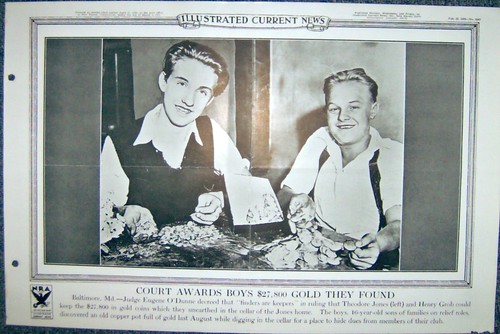
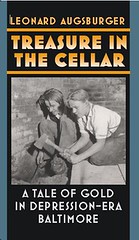 Russ adds:
In case you cannot read it, it says:
Russ adds:
In case you cannot read it, it says:
Baltimore, Md.- Judge Eugene O'Dunne decreed that "finders are keepers" in ruling that Theodore Jones (left) and Henry Grob could keep the $27,800 in gold coins which they unearthed in the cellar of the Jones home. The boys, 16-year-old sons of families on relief roles, discovered an old copper pot full of gold last August while digging in the cellar for a place to hide dues from members of their club.
Len Augsburger writes:
Neat! This photograph was also published in Popular Science, December, 1934, if memory serves.
MORE ON THE SWITT FAMILY 1933 DOUBLE EAGLES DECISION
The story stated:
After President Theodore Roosevelt had the U.S. abandon the gold standard, most of the 445,500 double eagles that the Philadelphia Mint had struck were melted into gold bars. However, a Philadelphia Mint cashier had managed to give or sell some of them to a local coin dealer, Israel Switt.
Joe Boling writes:
We have the same issue here that I saw in the open press version of this story - they have Teddy Roosevelt taking us off gold.
Ken Berger writes:
Franklin Roosevelt, not Theodore Roosevelt, took the U.S. off the gold standard.
To read the earlier E-Sylum article, see: JUDGE DECLARES SWITT FAMILY 1933 DOUBLE EAGLES GOVERNMENT PROPERTY (www.coinbooks.org/esylum_v15n38a07.html)
Judge Legrome D. Davis has confirmed a jury’s 2011 decision that the Langbord family’s 10 1933 Saint-Gaudens $20 double eagles are the property of the government.
On Aug. 29 in Philadelphia’s U.S. District Court, Judge Davis ruled in favor of the government, stating that the 10 1933 double eagles were not lawfully removed from the U.S. Mint and that as a matter of law they remain the property of the government regardless of how the coins came into the Langbord family’s possession.
The civil trial took place in July 2011 where a jury unanimously found that the government proved its position that the 10 coins should be forfeited by the Langbord family.
Barry H. Berke, the Langbords’ lead attorney, has stated that the family plans to appeal the decision. He said that the case raises many legal questions, “including the limits on the government’s power to confiscate property.”
The coins have been kept at the U.S. Bullion Depository at Fort Knox, Ky., and the government has not yet made a statement about what it will do with the coins. Deputy U.S. Mint Director Richard A. Peterson has stated that the coins will not be melted.
To read the complete article, see: Judge confirms jury decision on 1933 case (www.coinworld.com/articles/judge-confirms-jury-decision-on-1933-case/)
THE BOOK BAZARRE
ANA 2012 FALL NATIONAL MONEY SHOW EXHIBITS
The American Numismatic Association’s Museum Showcase will present a stunning array of numismatic treasures with a Texas connection during the 2012 Fall National Money Show. These and other rare, historically significant items will be on display in the showcase Oct. 18-20 at the Dallas Convention Center. The Harry W. Bass Jr. Collection Renowned collector Harry W. Bass, Jr. assembled a one-of-a-kind, early U.S. gold and pattern coin collection, which is housed at the ANA Edward C. Rochette Money Museum in Colorado Springs. About 80 rare objects from his collection will be publicly displayed in Dallas for the first time.
This exhibit will be complemented by the Money Talks presentation, “Harry W. Bass, Jr.: An Extraordinary Collector – A One-of-a-Kind Collection,” by ANA Gov. Gary Adkins. The talk will start at 1 p.m. Oct. 19 and is expected to be heavily attended.
“My talk will look at what drove Bass to pursue the coins he did. He amassed some beautiful, significant and very rare coins, and I’ll present some highlights from the collection,” Adkins said. “I’ll encourage people to see some phenomenal coins on display and let them know that if they really want to explore the entire collection, they can see it at the ANA’s Money Museum.”
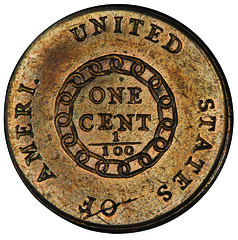 The 1793 Ameri Chain Cent
The 1793 Ameri Chain Cent
Possibly the first cent ever produced by the United States Mint, this coin is the finest known example of the “Ameri.” variety (“America” was abbreviated on the reverse legend). This coin was once part of the collection of Joseph Mickley, known as the “father of American coin collecting.”
1792 Silver Center Cent
The 1792 Silver Center cent is a pattern coin and a precursor to the large cent. As the U.S. Mint was designing the first cents, it was one of four designs considered. However, its silver core made mass production difficult and, ultimately, the copper large cent was introduced into circulation. Fewer than 20 examples exist today.
The 1792 Silver Center cent and 1793 Ameri Chain cent are courtesy of prominent Texas collector Bob R. Simpson.
Famous Errors
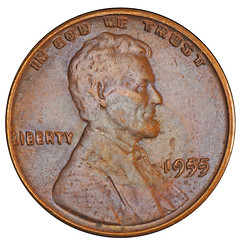
This exhibit acts as a highlight reel of some of the most notable numismatic bloopers. Since the discovery of the 1955 doubled-die Lincoln cent, collecting error coins has been an increasingly popular part of the hobby.
Bebee Error Notes
As paper money is printed, a variety of things can go wrong, as this exhibit shows. Double denominations; improperly aligned, inverted backs; obstructions between the printing cylinder and paper; overprints of seals; and inverted, misaligned and missing serial numbers are just a few of the errors seen on paper money.
Cutting problems can occur due to dull blades, paper jams, gutter folds and “butterfly” folds resulting from one or more wrinkles in the paper when part of the sheet folds over before printing.
This exhibit contains error notes from the collection of Aubrey and Adeline Bebee, which were donated to the ANA in 1987.
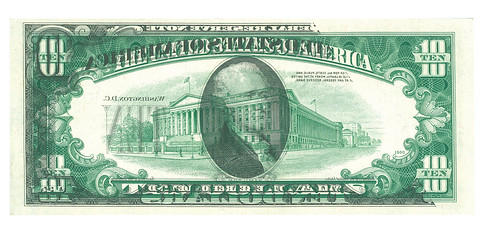
MONEY TALKS AT THE 2012 DALLAS ANA
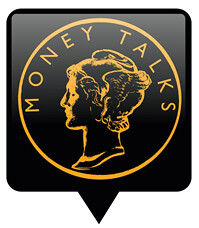 Friday, Oct. 19
Noon: “Paranormal Coins and Currency” Walter Ostromecki
Friday, Oct. 19
Noon: “Paranormal Coins and Currency” Walter Ostromecki
1 p.m.: “Harry W. Bass Jr.: An Extraordinary Collector – A One-of-a-Kind Collection” by Gary Adkins
3 p.m.: “1817 New Spain (Texas) Jolas: The Origin of the Lone Star Symbol for Texas” by James P. Bevill
Saturday, Oct. 20
1 p.m.: “Fractional Currency Look-a-Likes and Payables” by Benny Bolin
To read the complete article, see: Money Talks (www.nationalmoneyshow.com/activities,-special-events-classes/money-talks.aspx)
WAYNE'S NUMISMATIC DIARY: SEPTEMBER 16, 2012
September 11 was famous in my family long before 2001 - it's my sister Nancy's birthday. So before heading to work I dashed off a quick Happy Birthday email to her office address, knowing that would surely arrive before the birthday card I'd sent to her home via the U.S. Postal Service.
On the drive to work I was delighted to find a numismatic connection in the daily Writer's Almanac on National Public Radio. It was a poem about an elongated coin titled "At the County Fair, 1956" by Charles Darling.
For a nickel, a machine
called An Expression of Faith
would take your dime
and squash it.
All tubes and gears and lights,
the thing would groan, squeak,
fart, smoke, and finally drop
a little silver oval in your hands,
hot as a pistol,
with Jesus's face on one side
and the Lord's Prayer on the other.
I took my medallion
home for Grandma,
but she wouldn't keep it
because it was Catholic
and had "trespasses"
instead of "debts"
and left out the part
about the kingdom
and the power and the glory.
She gave it back
and I went downtown
and set it on the railroad track.
And after the train went by
I had a piece of silver
smooth as glass and that
says something about
power and glory, by God.
To read the complete issue on the web, see: http://writersalmanac.publicradio.org/index.php?date=2012/09/11
After work came one of my favorite parts of the month - the dinner meeting of my Northern Virginia numismatic social group, Nummis Nova. I arrived early at the Maggiano's restaurant in the Tyson's Galleria Mall. We'd just been to the mall on Saturday to take our daughter Hannah and a friend to the American Girl doll store.
At the door I met Gene Brandenburg and Dave Schenkman. Dave said he was happy to see me. He'd brought along a small box of rolls of 1960-D Large Date cents together with a pile of sales tax and other tokens, all meant as giveaways to the kids at an upcoming coin show. He was happy to see me because he was tired of carrying the stuff, which did weigh a ton.
The three of us met someone new before heading to our table - Steve Bishop had discovered our group on the web and written to me for information. I invited him as my guest. He brought along a nice group of medals, and later emailed me these images:

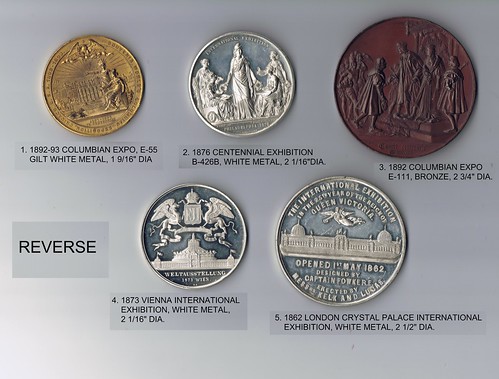
Other attendees included Eric Schena, Howard Daniel, Joe Levine, Jon Radel, Julian Leidman, and Roger Burdette.
Dave Schenkman brought along a lifesaving medal from the Merrimack Humane Society of Newburyport, MA and provided these images for The E-Sylum. He writes:
It appears to be made by engraving two silver discs with a reeded edge silver band. It is 42mm.
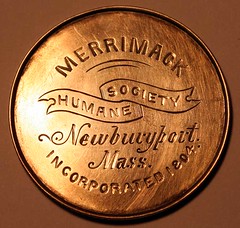
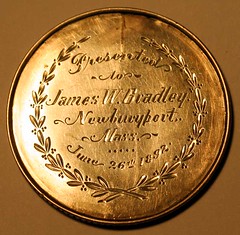
Eric Schena brought a number of items, too. He writes:
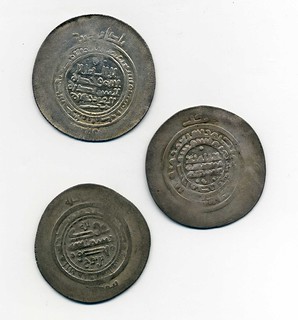 In keeping with the theme of the evening, I brought my small collection of medieval debased silver "multiple" dirhams from Afghanistan. There's some discussion as to what denominations these are supposed to be, either oversize dirhams or multiple dirhams, but their big claim to fame is that they are supposedly the first crown-size silver coins.
In keeping with the theme of the evening, I brought my small collection of medieval debased silver "multiple" dirhams from Afghanistan. There's some discussion as to what denominations these are supposed to be, either oversize dirhams or multiple dirhams, but their big claim to fame is that they are supposedly the first crown-size silver coins.
The majority of these were struck between AH 370 and AH 390 (980-1000 CE) and are between 40 and 45 mm in diameter. In my scan, the top one is Ghaznavid struck in Andaraba in AH 389 (999 CE) and is pretty much in as-struck condition. The middle one is a more typical undated Samanid/Banijurid example from Badakhshan, and the bottom one is also from Badakhshan, but was struck with two reverse dies. My understanding is that the vast majority of these came from one hoard found in the 1960s.
On another topic Eric writes:
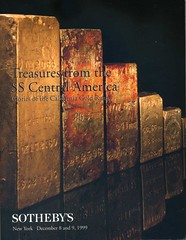 Based on our last dinner and seeing a sales catalog with some of the S.S. Central America ingots, I remembered to bring my copy of the sale catalog that never was, Sotheby's Treasures from the S. S. Central America, 8-9 Dec 1999. I ordered the catalog because I love reading about pioneer gold and then shortly thereafter, I got a notice saying the sale was cancelled due to a court injunction - I even saved the notice to go with the catalog. It's a fantastic catalog in its own right with a fascinating back story to boot.
Based on our last dinner and seeing a sales catalog with some of the S.S. Central America ingots, I remembered to bring my copy of the sale catalog that never was, Sotheby's Treasures from the S. S. Central America, 8-9 Dec 1999. I ordered the catalog because I love reading about pioneer gold and then shortly thereafter, I got a notice saying the sale was cancelled due to a court injunction - I even saved the notice to go with the catalog. It's a fantastic catalog in its own right with a fascinating back story to boot.
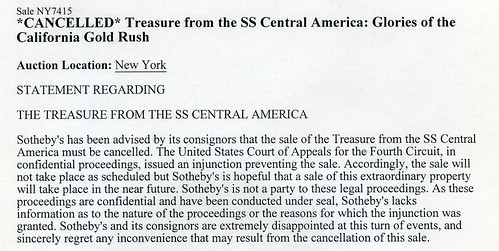
Gene Brandenburg brought along an interesting overstamped piece of German notgeld.
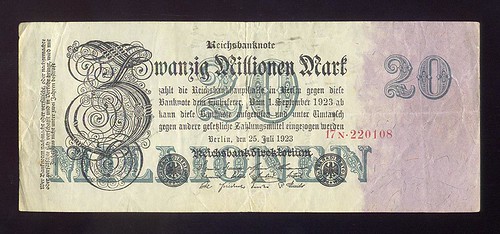
Gene writes:
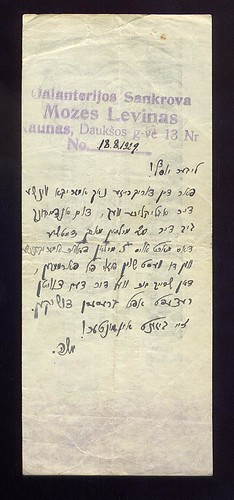 I pulled the note from an old bundle of these that I have had for quite some time (it was the only one with Mr. Levinas's backstamp). I didn't recognize the language, but Google Translate (God bless Google!) identified it as Lithuanian. Fumbling along, I learned that Mr. Levinas was a merchant in Kaunas - Lithuania's second largest city.
I pulled the note from an old bundle of these that I have had for quite some time (it was the only one with Mr. Levinas's backstamp). I didn't recognize the language, but Google Translate (God bless Google!) identified it as Lithuanian. Fumbling along, I learned that Mr. Levinas was a merchant in Kaunas - Lithuania's second largest city.
Mesmerized by this man, I eventually came across a wonderful website - jewishgen.org - which among other things is a large database of those who lost their lives during the holocaust. It listed Mr. Levinas's marriage (including the rabbi's name who performed the ceremony), and eventual divorce in 1929. Lithuania was the first country where the German SS started murdering Jews and it's doubtful that Mr. Levinas survived beyond 1940-41.
The handwritten script below the backstamp is a puzzle. Joe Levine said that it didn't look "kosher" but Julian Leidman said that it did, and he'll try to have it translated. I'm wondering if anyone else would have a go at translating it. I feel an odd affinity for this man who owned this note, on the tiny chance that there is a descendant of Mr. Levinas out there I would gladly forward this note to them.
Julian Leidman's fellow congregant Rita Rubinstein translated the Yiddish writing as follows:
8/18/1929
Dear Josef,
For your return trip to the U. S. I wish you a safe and happy voyage. I am giving you a memento of 20 million German mark that translates into 5 Million dollars in American money. No (as translated) you’ll own a lot of money. Write to me and I’ll send you more medicine and money.
Be healthy and hopeful.
` Moshe
Moses Levinas
Julian adds:
Interesting as Moses knew that the money was essentially worthless. I wonder whether this was tongue-in-cheek. Rita was impressed with the gift until I explained that the money was not what it seemed.
We had ordered our dinner Family Style, and the staff kept bringing out plate after plate of delicious salmon, lasagna and other specialties until we cried Uncle. The desserts were excellent as well. The night was over all too soon. We wished Howard well - it would be the last meeting he'll make for a while, as he'll be spending six months in Vietnam. Good luck Howard - we'll miss you.
As a parting note, today (September 16th) is my wife Dee's birthday. She's turning ... well, nevermind. Happy Birthday!
NOTES ON THE ALBANY CHURCH PENNY
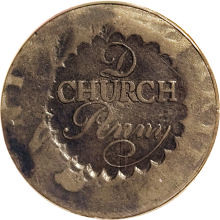 A most enjoyable issue of The E-Sylum last week. I love seeing the brainy, fun and useful contributions of friends such as Dick Johnson, Kay Freeman and Dennis Tucker (among many others) that appear each week.
A most enjoyable issue of The E-Sylum last week. I love seeing the brainy, fun and useful contributions of friends such as Dick Johnson, Kay Freeman and Dennis Tucker (among many others) that appear each week.
Richard Gascoyne of the First Presbyterian Church inquired about the famous Albany Church Penny. I used the same quotation he cited, of his church's resolution authorizing the issue, in my coverage of the penny as Number 37 in Whitman's i>100 Greatest American Medals and Tokens. I found the quotation W. Elliot Woodward's sale of April 28, 1863, Lot 2079. So interest in these pieces is pretty well established!
Walter Breen's Complete Encyclopedia of U.S. and Colonial Coins is available in many libraries. It devotes a brief chapter to church and communion tokens, and states that their use dates back to the 1635 Liturgy of the Scottish Presbyterian Church. He lists 14 different American issues, and does not include any minted after 1800. Probably the scarcity of small coinage was the main reason for the Albany penny issue. In 1792, according to an online history of the City of Troy, NY, another Presbyterian church issued paper scrip: www.rootsweb.ancestry.com/~nyrensse/troy.htm .
It is my guess that members of First Presbyterian stopped using their church pennies as soon as Federal cents became available in 1793 or soon afterward.
I found a reference in an 1898 issue of the Ladies' Home Journal exhorting readers to abandon the practice of tithing only a penny. She said, "such an offering is an insult to God and His church, and the sooner people see the matter in this hard, true light, the better."
To read the earlier E-Sylum article, see: QUERY: ALBANY CHURCH PENNY INFORMATION SOUGHT (www.coinbooks.org/esylum_v15n38a12.html)
QUERY: WHAT IS A PORTUGALOZER?
Tom Wetter writes:
Question: What is a Portugalozer? Google is stumped. Thomas Elder has one catalogued in his November 1934 sale. His exact listing is "PORTUGALOZER OF JOHN III
QUERY: GARRETT TAIPING REBELS SILVER CASH INFORMATION SOUGHT
I need a couple images from one or two sales in the 1980's held by Numismatic Fine Arts (NFA) and Bank Leu AG. After the Garrett Collection of US coins was sold in 1978-1980, the foreign and ancient coins in the collection, formerly housed at Johns Hopkins University, were sold in three sales by NFA and Bank Leu. The first was in May 1984; the second was 16-18 October 1984; and the last on 29 March 1985.
The Garrett Collection is said to have had three examples of a silver cash coin (with the square hole in the center) issued by the Taiping rebels in China about 1860. I am updating my listing of known examples of these coins (about 25 known), and need images of those from the Garrett Collection.
One piece was sold in the first sale. I own the catalog of the first sale, so I don't need that. What I need are scans and data on the other two pieces. I assume they were sold in one or both of the other two sales. I need this information rather quickly, so if anyone has these two catalogs, could you scan the two coins and note the size and weight of each piece, and send the information to me? Thanks. I can be reached at chinasmithbr@yahoo.com .
MUHAMMAD ALI RECEIVES LIBERTY MEDAL
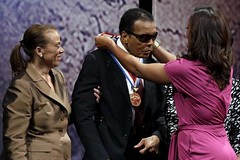 Retired boxing champ Muhammad Ali was known as ‘‘The Greatest’’ inside the ring. But some say the moniker has been even more fitting in the years since he hung up his gloves.
Retired boxing champ Muhammad Ali was known as ‘‘The Greatest’’ inside the ring. But some say the moniker has been even more fitting in the years since he hung up his gloves.
Ali came to Philadelphia on Thursday to receive the Liberty Medal for his longtime role as a heavyweight for humanitarian causes, civil rights and religious freedom. Among those celebrating his latest honor at the National Constitution Center were former NBA star Dikembe Mutombo and Joe Louis Barrow II, the son of boxer Joe Louis.
‘‘Knowing you since I was a little boy has given me a ringside seat to history,’’ an emotional Barrow said. ‘‘But it’s your character outside the ring that speaks to the hope of the least and lost among us.’’
The 70-year-old Ali, hobbled by a 30-year battle with Parkinson’s disease, did not speak. But he stood with assistance to receive the medal from his daughter Laila Ali.
He looked down at his medal for several moments and then waved to the crowd. The award comes with a $100,000 cash prize.
Ali was born Cassius Clay but changed his name after converting to Islam in the 1960s. He refused to serve in the Vietnam War because of his religious beliefs and was stripped of his heavyweight crown in 1967. A U.S. Supreme Court ruling later cleared him of a draft evasion conviction, and he regained the boxing title in 1974 and again 1978.
To read the complete article, see:
For Muhammad Ali, a Liberty Medal in Philly
(www.boston.com/ae/celebrity/2012/09/14/for-muhammad-ali
-liberty-medal-philly/SEDQ14kE6jDvjyabn82BBN/story.html)
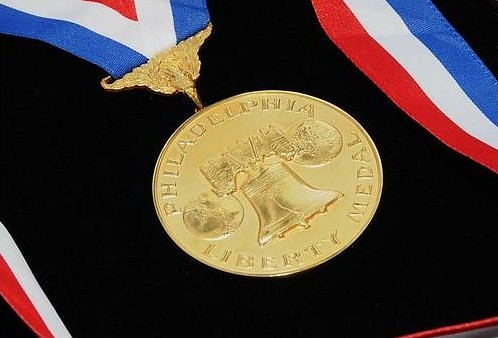
The Liberty Medal is awarded annually by the National Constitution Center to men and women of courage and conviction who have strived to secure the blessings of liberty to people the world over. The Medal’s roster of recipients includes many of the men, women, and organizations that have shaped and guided the world through the past two decades, including Nelson Mandela, Sandra Day O’Connor, Kofi Annan, Shimon Peres, and Colin Powell.
To read the complete article, see: constitutioncenter.org/libertymedal/
ARNOLD PALMER RECEIVES CONGRESSIONAL GOLD MEDAL
Arnold Palmer has received many trophies and awards for his prowess on the golf course, but he said Wednesday the two national medals he has received mean the most.
Mr. Palmer, who turned 83 on Monday, received his Congressional Gold Medal at the Capitol on Wednesday in recognition of not only his contributions to the game of golf but also his humanitarianism.
Congress voted to award the medal in 2009, but it has taken three years for the U.S. Mint to design and produce the gold coin depicting Mr. Palmer's image. As the honoree, he had some say over the design but didn't see the finished product until Wednesday.
During a ceremony in the Capitol rotunda, House and Senate leaders presented the medal, which is considered one of the nation's highest expressions of appreciation, matched only by the Presidential Medal of Freedom, which Mr. Arnold was awarded eight years ago.
The medal honors contributions to American history and culture as well as major achievements in the recipient's field. It's been awarded to war heroes, explorers, actors, authors, entertainers and others, including Jonas Salk, who developed the polio vaccine at the University of Pittsburgh; Roberto Clemente, the Pirates outfielder; and Gen. George C. Marshall, chief of staff during World War II and a Uniontown native, and Gen. Matthew C. Ridgway, the Korean War commander who retired to Fox Chapel. Mr. Palmer is the second golfer to receive the honor; the first was Byron Nelson.
To read the complete article, see:
Gold Medal another ace for Arnie Palmer
(www.post-gazette.com/stories/local/westmoreland/gold-medal-another
-ace-for-arnie-palmer-653087/)
THE FELIX WASSERMANN COLLECTION OF GOLD COINS
Art Friedberg writes:
On behalf of our colleagues at Hess-Divo AG in Zürich and Fritz-Rudolf Künker GmbH in Osnabrück we are forwarding the attached interesting story on an important collection of gold coins that has been out of public view since the 1930's. It will be sold on October 26.
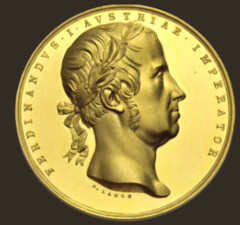 A collection of several hundred coins, including many rare pieces unseen since the 1930's will be sold at a public auction in Zürich on October 26. The sale, conducted by the firms of Hess-Divo AG of Zürich in cooperation with Fritz Rudolf Künker GmbH & Co. of Osnabrück, Germany, is composed of coins secretly removed from Nazi Germany in 1938 by a Jewish family fleeing the imminent Holocaust. The coins have remained in bank vaults and off the market since their acquisition more than 75 years ago, and it is only with the release of the auction catalog that the public is being made aware of their existence for the first time.
A collection of several hundred coins, including many rare pieces unseen since the 1930's will be sold at a public auction in Zürich on October 26. The sale, conducted by the firms of Hess-Divo AG of Zürich in cooperation with Fritz Rudolf Künker GmbH & Co. of Osnabrück, Germany, is composed of coins secretly removed from Nazi Germany in 1938 by a Jewish family fleeing the imminent Holocaust. The coins have remained in bank vaults and off the market since their acquisition more than 75 years ago, and it is only with the release of the auction catalog that the public is being made aware of their existence for the first time.
It was in the early 1930s that Dr. Felix Wassermann, a physician living in Munich, began to recognize the threats of political turmoil and persecution caused by the rise to power of the Nazis in Germany. So motivated, he undertook to protect his family by amassing a portable asset and started collecting gold coins. Ultimately, Felix’s prescience proved accurate. In 1938, in advance of World War II and the Holocaust, he along with his wife Susan, son Charles and daughter Eva emigrated to the United States.
Charles F. Wasserman, the son of Felix, finished his high school education in New York City. Charles became a well-known pediatrician in New Orleans and remained very attached to his German roots. He did not consider himself a traditional "collector", but prized the family coins for what they represented: a tangible symbol of his family's history and heritage. Dr. Charles F. Wasserman passed away in March, 2012.
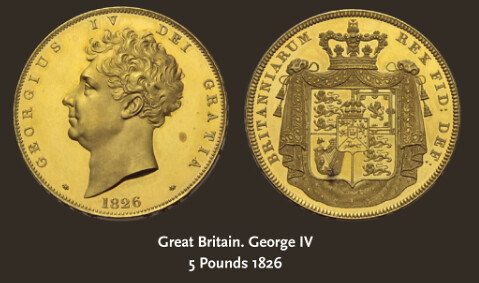
The dealers whose coins came to form the Wasserman Collection are a proverbial who's who of early twentieth century German numismatics. Some time in 1931, it is believed, Felix consulted with Gerhard Hirsch of the numismatic firm in Munich which still bears his name today. He then began making a large number of purchases. Among his sources were Otto Helbing, Julius Jenke, and Eugen Merzbacher (all of Munich); Leo Hamburger, Adolph Hess, Sally Rosenberg, and Adolph Cahn (Frankfurt); and Jacques Schulman (Netherlands).
It is not always easy to reconstruct the history of a collection based only on the coins it contains. It is clear that the motive was far less numismatic than it was wealth-protective. It is not known exactly how the Wassermanns were able to remove the coins from Germany at a time when laws were being instituted which forbade emigrating Jews from taking their belongings and savings with them.
To view the auction catalog visit www.sixbid.com after September 17. Bidders can also participate in the auction live and in real time on the Internet as long as they register in advance at www.hessdivo.com. To order a printed version of the auction catalog please contact Hess Divo AG at +41 (0)44 225 40 90 or via email: mailbox@hessdivo.com or Künker service team at +49 (0) 541 962020 or via email: service@kuenker.de.
THE BOOK BAZARRE
COIN SMUGGLING ATTEMPTS THWARTED IN EGYPT AND ABU DHABI
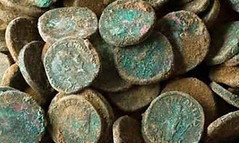 Today, the Antiquities Unite at Borg Al-Arab airport in Alexandria succeeded to abort two smuggling attempts of a large collection of authentic coins.
Today, the Antiquities Unite at Borg Al-Arab airport in Alexandria succeeded to abort two smuggling attempts of a large collection of authentic coins.
The authentic coins were packed in two parcels mixed with a collection of commemorative coins within the luggage of two Egyptians who are travelling to Gheda and Dammam in Saudi Arabia.
Mohamed Ibrahim minister of State for Antiquities said that the arrest of both criminals carried out in collaboration with the customs and Police of Borg Al-Arab airport.
He explains that the first parcel was filled with 1080 coins and the second has 106 coins. An archaeological committee lead by Hassan Rasmi head of the Antiquities Unites has inspected both confiscated boxes and finds out that only 134 of the 2266 coins are authentic and the others are only commemorative coins.
Rasmi pointed out that the coins are dated to the Graeco-Roman, Umayyad, Ottoman and Mohamed Ali eras. They are now at the ministry restoration labs for restoration and then put on display at the Islamic museum.
To read the complete article, see:
MSA aborted two foiled smuggling attempts of authentic coins
(english.ahram.org.eg/NewsContent/9/43/52146/Heritage/
Islamic/MSA-aborted-two-foiled-smuggling-attempts-of-authe.aspx)
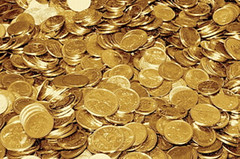 Cops in Abu Dhabi have arrested three men caught with historical gold coins worth Dhs2.5 million.
Cops in Abu Dhabi have arrested three men caught with historical gold coins worth Dhs2.5 million.
The coins were once used as currency in ancient Islamic regimes in Arabia. The Arab suspects, aged between 28 and 29, were caught in the capital by CID officials. The coins were 23 and 24 carat gold.
Police said the men had been trying to find a buyer. It is not clear how the suspects acquired the coins but police said the men had been under surveillance since the force received information about their activities.
The men, including two truck drivers, are believed to have brought the coins in from a neighbouring country.
Menhali added that the UAE is committed to fighting illegal trading in antiquities and cultural property.
To read the complete article, see:
Abu Dhabi police arrest men with ancient gold coins
(www.7daysindubai.com/Abu-Dhabi-police-arrest-men-ancient-gold-coins
/story-16829498-detail/story.html)
SIOUX CITY CORN PALACE FESTIVAL MEDALS
 COLLECTABLE COIN: A beautiful Corn Palace souvenir in the shape of a medal has been designed by the United States mint at Philadelphia. The metal will be about the size of a silver quarter and heavily plated with gold. On one side are the names of “Iowa Dakota, Minnesota, and Nebraska.” In the center are the words: “Souvenir of the harvest festival.” On the reverse side is a die of the Corn Palace, with the words “Corn Palace,” over the die, and underneath the words “Sioux City,
COLLECTABLE COIN: A beautiful Corn Palace souvenir in the shape of a medal has been designed by the United States mint at Philadelphia. The metal will be about the size of a silver quarter and heavily plated with gold. On one side are the names of “Iowa Dakota, Minnesota, and Nebraska.” In the center are the words: “Souvenir of the harvest festival.” On the reverse side is a die of the Corn Palace, with the words “Corn Palace,” over the die, and underneath the words “Sioux City,
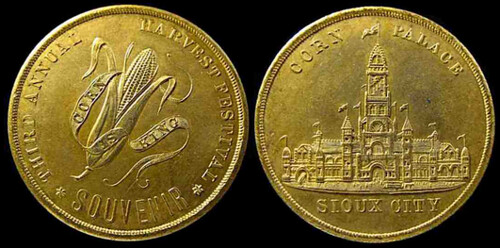
To read the complete article, see:
125 years ago: Coin pressed for Sioux City Corn Palace festival
(siouxcityjournal.com/news/local/columnists/peterson/years-ago-coin-pressed
-for-sioux-city-corn-palace-festival/article_9ad37511-648e-5ce4
-8008-f1bb04d831f3.html)
MORE ON THAT ENGRAVED 1840-O HALF DOLLAR
Bill Bugert writes:
I received this note on the engraved 1840-O half dollar previously mentioned in the E-Gobrecht and E-Sylum. Paul's explanation is the best I've heard and the most logical I've heard by far by far.
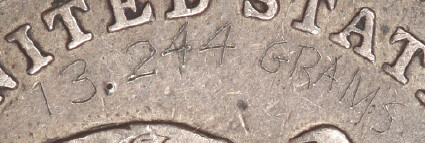
Paul Schultz writes:
I propose a reason for the engraved weight on the 1840 dollar coin. When a scale must be calibrated or proven to be accurate, a standardized weight of known certain value must be used to compare with the weight that the scale indicates for it. Nowadays, you can purchase standards at the National Institute of Standards and Technology, known for many years as the National Bureau of Standards. A century or more ago, someone probably wanted to calibrate their scale, and so weighed your coin on a scale that was trusted and known to be accurate, and then used that known weight to test their own scale which was perhaps uncertain. A coin is ideal, since it is corrosion resistant (won't change in weight) and rather wear resistant too.
To read the earlier E-Sylum article, see: QUERY: AN ENGRAVED 1840-O HALF DOLLAR (www.coinbooks.org/esylum_v15n33a11.html)
THE CURIOSITY'S 1909 CENT PICKS UP LAYER OF MARTIAN DUST
Len Augsburger writes:
Am I the only person who didn't know there was a 1909 Lincoln cent on Mars??
Engineers testing the Curiosity Mars rover are wrapping up a series of robot arm calibration and motion tests before resuming a slow trek toward a nearby rock formation this weekend, on the lookout for a suitable stone to reach out and touch in an initial round of "contact science," officials said today.
NASA unveiled striking new photographs Wednesday, including a panorama shot by the MAHLI camera at near ground level showing the undercarriage of the rover with its eventual target -- Mount Sharp -- rising in the background. Other photos showed covers opening and closing on the rover's upper deck exposing inlets where soil samples eventually will be deposited into a sophisticated analytical instrument.
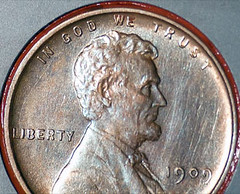

The Curiosity Cents, Before and After
The MAHLI camera also captured an extreme closeup view of a 1909 penny that serves as a calibration target. Tiny dust grains blown up onto the spacecraft by its landing rockets are clearly visible. The resolution of the closeup image is 25 microns per pixel. If the camera can be positioned close enough to a potential target, that resolution could improve to 14 microns per pixel.
To read the complete article, see:
Robot arm in good shape, Mars rover set to resume trek
(news.cnet.com/8301-11386_3-57511644-76/robot-arm-in-good-shape
-mars-rover-set-to-resume-trek/)
To read a NASA page sent by Philip Mernick, see: Lincoln Penny on Mars in Camera's Calibration Target (www.nasa.gov/mission_pages/msl/multimedia/pia16131.html)
To read the earlier E-Sylum article, see: IS A 1909 VDB LINCOLN CENT GOING TO MARS? (www.coinbooks.org/esylum_v15n07a25.html)
WHAT COINS SHOULD ACCOMPANY FROZEN PEOPLE TO THE FUTURE?
If you could go into a frozen sleep and wake up like Rip Van Winkle, only hundreds of years in the future, what assets would you want with you?
A popular theme in science fiction movies is having the main characters frozen then scientifically brought back to life in the future. Stars such as Mel Gibson (“Forever Young”), Tom Cruise (“Vanilla Sky”), Sigourney Weaver (the “Alien” films) and Sylvester Stallone (“Demolition Man”) and many others use this technology for key parts of the movies.
The technology for placing the recently deceased into what could be called “an ambulance to the medical technology of the future” is called cryonics.
Besides being a coin dealer, I developed an interest in the possibility of cryonics in the 1970s after reading Robert A. Heinlein’s book, “The Door Into Summer.” I have served as an unpaid officer and director for Cryonics Institute, one of the non-profit organizations now providing cryonics services since it was established in 1976. I am one of at least three coin dealers who have signed contracts to have their bodies immersed in liquid nitrogen upon death (but I won’t tell you who the others are, as this information may or may not be private to them, whereas I even wrote on the subject for The Wall Street Journal back in the 1980s).
One of the questions that those interested in cryonics ask is what would be a suitable investment today that would hold its value or appreciate over the possible centuries that it might take for medicine to develop the capability to revitalize and rejuvenate people.
Last week, a Cryonics Institute member asked me if I would consider any numismatic items that were not related to bullion value to be suitable for an ultra-long holding period, say in the range of 100 to 500 years. I don’t have a surefire answer to this inquiry and I am hoping that some readers could offer their thoughts on the subject.
To read the complete article, see: Coins to Be Frozen With? (www.numismaster.com/ta/numis/Article.jsp?ad=article&ArticleId=25741)
LIBRARIAN TATTOOS

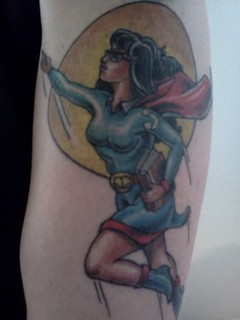 Elizabeth Skene (above) has what might be the most awesomely complete librarian sleeve around, featuring a skull sitting on top of a book, with a graduation cap next to a card catalog with a banner reading “Peace and Knowledge.” There is also an open book with pages coming out and turning into birds. Let there be no doubt here: Elizabeth loves libraries.
Elizabeth Skene (above) has what might be the most awesomely complete librarian sleeve around, featuring a skull sitting on top of a book, with a graduation cap next to a card catalog with a banner reading “Peace and Knowledge.” There is also an open book with pages coming out and turning into birds. Let there be no doubt here: Elizabeth loves libraries.
Tattooed Librarians and Archivists reader Michelle (right) is a high school librarian who wanted to get something to represent her career. She chose a superhero librarian and based the design on the old-school DC character Mary Marvel and had it inked by Chris Cockrill of Avalon II Tattoo. I think the world could use a few more super librarians, don’t you?
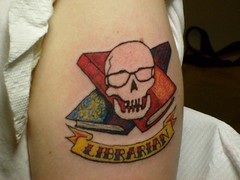 Prefer your ink a little more hardcore than most of these librarian tattoos? Then, you’ll probably approve of Jason Puckett’s tattoo by Ron Hendon of Midnight Iguana Tattooing that features a bespectacled skull with “crossbooks” and a “librarian” banner.
Prefer your ink a little more hardcore than most of these librarian tattoos? Then, you’ll probably approve of Jason Puckett’s tattoo by Ron Hendon of Midnight Iguana Tattooing that features a bespectacled skull with “crossbooks” and a “librarian” banner.
To read the complete article, see: 11 Amazing Librarian Tattoos (www.mentalfloss.com/blogs/archives/141087)
FEATURED WEB PAGE: PAINTINGS ON PENNIES
In another form of art, this week's Featured Web Page is the work of Jacqueline Lou Skaggs, who has created some interesting paintings on U.S. one-cent coins. Check 'em out!This small body of twelve works consist of images painted on found, discarded pennies and reflect a decision to move away from making "pictorial" images. A grand finale of sorts paying homage to the binding ideologies that define our family, religious, social and political worlds. Paid tribute no less on the face of discarded coins these iconic images transcend the coins value while defacing it.

jacquelinelouskaggs.com/section/
192725_Tondi_observations.html
